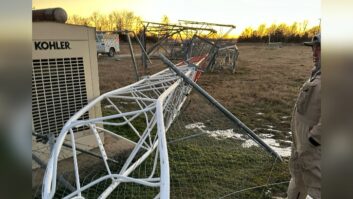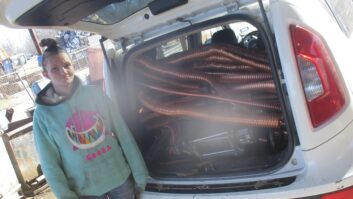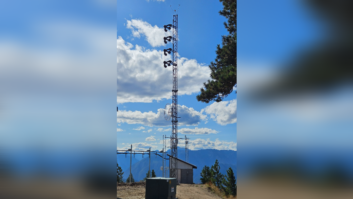(click thumbnail)Figure 1 : What’s wrong up on that tower? You’re enjoying the afternoon, when suddenly your cell phone rings. A frantic receptionist conferences you with a lady who reports that someone has climbed your tower, and has set himself on fire – committing suicide, she reports. The smoke is clearly visible, as you can see in Figure 1.
But you break out in laughter.
Practical joke? Just another crazy day in radio? We’ll tell you more at the end of the column.

. . .
Spring is a good time to make a thorough inspection outdoors – not only at the transmitter site, but on the roof of your studio complex.
A visual check of STL lines can spot problems before they occur. So what do you look for?
Are there grounds on the coax lines? If the weatherproofing compound has dried and cracked, figure water seepage won’t be far behind.
Have you kept a log of your STL transmitter parameters? I used to use those easy-peel Avery labels so the front panel of the STL wouldn’t be marred. All of the STL parameters were printed on the label, along with the date.
Water getting into STL connectors will cause reflected power to increase.
As you inspect the STL lines, also check the pigtails. These 2- to 3-foot jumpers that flex from the main STL line to the antenna can and will fail. Check for cracks in the outer jacket.
I always made it a rule to keep at least two spare pigtails. When the old ones were replaced, they were thrown away. There’s nothing more frustrating than having a box full of pigtails in unknown condition. Don’t waste your time; get rid of defective materials.
(click thumbnail)Figure 2: Beautiful weather is a great excuse to check out what’s happening on your building roof.
The feed dipoles of the STL dish also can fail – although it’s expensive, a spare is not a bad idea, especially if you care for several stations with the same type of STL dish.
If, during your inspection, you find that the connector ends are not weatherproofed, invest in a good weatherproofing kit from the manufacturer of your line. Yes, electrical tape will work, but it won’t last the way the appropriate weatherproofing kit will. Why do the job twice?
The painting contractor is using compressed water to blast-clean the towers.
Check that the lines are tagged. We spoke about the tags sold by Antenna ID Products (phone (610) 458-8418) a while back. Knowing which line runs to which STL again can save a tremendous amount of time in an emergency. Now, when everything is working fine and the days are getting nicer, is a good time to tag your lines and document your STL system.
Documenting the STL system helps resolve other problems.
I’ve seen instances in which dish mounts have come loose, and the dish is not pointing at the receive location. Another problem is where the dish is aligned in a horizontal plane, and the feed dipole is set for vertical.
What does the mounting hardware look like? Is it loose; are the tower or building mounts secure? While on the roof, also check your scanner, mod monitor and EAS receiver antennas. Again, check the mounts for security or missing hardware.
Where television antennas are used for your off-air monitor, inspect the RF connection. Late-model antennas typically use type “F” connectors, but some still use twist lugs or screws which can corrode. The flexing of the antenna in the wind can also loosen or break the coax connection.
Inspect how the coax is supported. This is especially true for yagis, where the line may be looped through the antenna, or worse, connected with white wireties that long ago disintegrated.
(click thumbnail)Figure 3: Seal cable-entry pipes to keep out the elements.
Perform a similar inspection for any satellite dishes that are rooftop-mounted.
As you follow the cables to their building entry, focus on what the cable entry holes look like. Are they plugged with dum-dum, RTV or foam sealant, or will they permit insects and water to enter the building?
Figure 3 shows properly sealed pipes. You might note the flexible plastic-coated conduit protruding from the passage pipe. The cables exiting are for a satellite dish. The flexible conduit will protect the cables as they run over the roof to the dish – good (and cheap) insurance.
(click thumbnail)Figure 4: The painting contractor is using compressed water to blast-clean the towers.
I remember being called to a station that was off the air. They lost their satellite feed while their engineer was on vacation. It didn’t take long to find the coax, or what was left of it, lying on top of the ground, on the way to the dish, mounted out back.
The engineer was told to get the dish in ASAP – you know the routine, one of those last-minute satellite programs, or maybe a format change! Either way, the line had been hacked by both a lawnmower and a weed whacker, taking the station off the air.



. . .
Back to the tower smoke. The laughter from the engineer taking the report of the suicide on his tower was not a case of insensitivity.
Although it looked like someone was indeed smokin’, the whole scenario was planned. His tower painting contractor used compressed water to waterblast the towers before painting them.
Figure 4 clears up the problem that could have been on the 6 o’clock news. As you get a chuckle from this photo, note how the base insulators were wrapped to prevent their being painted.
And thank you to Art Rose and Dave Garner with Bonneville’s WTOP in Washington, D.C., for sharing the pictures with our Workbench readers.
Submissions for this column are encouraged, and qualify for SBE recertification credit. Fax your submission to (703) 323-8044, or send e-mail to[email protected].












